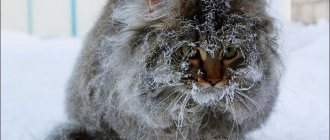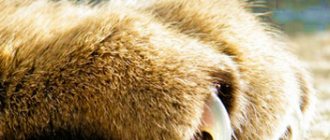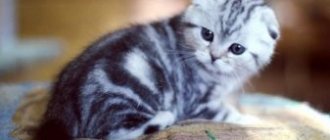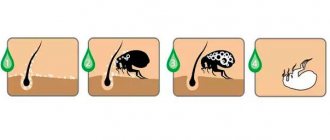According to WCF rules, for cats aged >10 months. There are 6 main titles that can be earned by winning competitions and receiving a specified number of points. To participate in the nomination, a pet must meet the criteria of purebred, health, physical fitness and good behavior. To be awarded the first 2 titles, you need to participate in exhibitions taking place in 1 country. In order to breed purebred cats, according to experts, you must earn at least the title of Champion (Ch).
FARUS titles
| Hierarchy of titles FARUS | |
| 6. Best Of Best | BOB |
| 5. Grand European Champion Grand European Champion | GECh. |
| 4. European Champion European champion | E.Ch. |
| 3. Grand International Champion Grand International Champion | GICh. |
| 2. International Champion International champion | I.Ch. |
| 1. Champion - Champion | Ch. |
Title award system in FARUS (FAR)
Junior Champion
(from 6 to 10 months) is awarded after receiving three JCAC titles from three different judges.
The title is equivalent to a “divorceable” title, that is, permission for breeding use. Champion
(from 10 months) – 3 CAC titles from three different judges.
International Champion
– 3 CACIB titles from 3 different judges.
One of the assessments must be “exit”, that is, obtained in any other city. Or 4 CACIB titles from different judges without traveling to another city. Grand International Champion
- 3 CAGCIB titles from different judges, one assessment away, or 5 CAGCIB titles from different judges without traveling to another city.
European Champion
– 3 CACE titles from different judges, two on-site assessments.
Without traveling to another city, 2 title assessments must be obtained at FARUS (FAR) exhibitions in competition, at least 3 animals in the breed. Grand European Champion
– 5 CAGCE titles from different judges, two on-site assessments.
Without traveling to another city, 2 title scores must be obtained at FARUS (FAR) exhibitions in competition, at least 3 animals in the breed. Best of the Best Champion (BOBCH)
– 1) 6 evaluations with the award of the title from different judges at FARUS exhibitions, of which 3 evaluations in competition with at least 3 applicants for this title or 3 on-site evaluations in different cities. 2) In addition to 6 BOBCH/BOBCP titles, 4 prestigious titles must also be obtained, which include: First places in single-breed rings at FARUS exhibitions or first places in adult animal rings under the WCF and FARUS systems. And also the first three places in the final Best of Best competition 1, 2, 3.
For details, see the official FARUS website.
WCF classification
Long-haired cat breeds
These include, for example, the Himalayan, Persian, and colorpoint cats. A distinctive feature is long hair that requires combing.
Semi-longhair
A large group that includes the Japanese Longhair Bobtail, Highland Fold, Turkish Van and Turkish Angora, Siberian, Masquerade Neva, Somali and many others. These pets are also fluffy, but their hair is not so long.
Shorthair
Another large group. These include the Abyssinian, Tabby, American Wirehair, Shorthaired American Curl, Bengal and Bombay, Celtic and many others. Their fur is short, sometimes - like, for example, the Don Sphynx - almost invisible.
Siamese-Oriental Shorthair
This is a special group that includes both the Siamese cats themselves and the breeds obtained by crossing Siamese and European cats. This group also includes breeds that are in no way related to Orientals and Siamese cats, but have similar features to them.
TICA titles
At the TICA exhibition, a cat can receive any title only if it reaches the final (best) of the ring. For one exhibition you can receive several titles at once.
Order of reaching the finals:
- First, the cat competes with cats and cats of the same breed in its color (for example, wild), where the 5 best animals of this color are selected.
- Then - in the color division (the Abyssinian breed has two divisions: tabby and silver). In the tabby division cats of all four colors compete: wild, blue, sorrel and fawn. In the silver division - cats with silver variants of these colors.
- Then the three best representatives of the breed are selected.
- And finally, a comparison with the best representatives of other breeds. In the case of the Allbreed ring, the 10 best cats from all judged breeds are selected for the finals, and in the case of the Specialty ring, the finals are held separately for CA and DS cats.
During judging, cats receive points for places in color and in division (color group). For places in color:
- Best of Color – 25 points
- 2nd Best of Color – 20 points
- 3rd Best of Color – 15 points
- 4th Best of Color – 10 points
- 5th Best of Color – 5 points
For places in the division:
- Best of Division – 25 points
- 2nd Best of Division – 20 points
- 3rd Best of Division – 15 points
However, points themselves are not a title. A cat can score a fairly high amount of points for an exhibition, especially if the cat is of a rare color - such a cat will automatically become the best in color and division. But if a cat does not reach the final, it will not receive the title, no matter how many points it scores.
For details, visit the official TICA website.
WCF rings
With WCF rings everything is simple, there are four of them (usually there are three or two of them at exhibitions): Adult; Junior; Kitten and Neuter. Kitten and Junior are sometimes combined into one ring.
Each ring features a minimum of 10 cats of the appropriate age, all genders and all breeds. Only non-castrated animals participate in Adult, Junior and Kittten, and only neutered animals in Neuter.
The expert distributes the participants into 10 places (the number of places should not exceed 50% of the number of cats in the ring, therefore, when there are few cats, there are fewer places). Participation in rings is paid separately, it is not necessary, but receiving an award in the ring is an additional bonus for both the cat and the cattery/breeder. In addition, winning the ring gives you the right to take part in the master ring and receive points for the ranking of the best cats.
FIFe titles
To obtain the title of "Champion", a cat must obtain three CAC (Candidate for Champion) certificates from three different judges at three national or international shows under the auspices of FIFe.
The rules for obtaining higher titles are as follows:
- Interchampion – five CACIB certificates from three different judges in one country (for Russia).
- Grand Interchampion – seven CAGCIB certificates from three different judges in two countries.
- Supreme Champion - nine CACE certificates from three different judges in three different countries at international exhibitions under the auspices of FIFe.
For details, visit the official FIFe website.
FIFE classification
FIFE also has four groups. They almost repeat the WCF classification, but differ in nuances.
Exotic and Persian
These include Himalayan, Persian, exotic (as a breed) cats, colorpoints. They have a similar nose shape and coat length.
Semi-longhair
Turkish Vans and Angoras, masquerade Neva and Siberian cats, sacred Burmese cats and ragdolls - in general, this group is practically no different in composition from the semi-longhair group according to the WCF.
Shorthair and Somali
Cymrik, Korat, Egyptian Mau, Don Sphynx, Somalia - there are quite a lot of cat breeds in this group.
Oriental (eastern)
These included the Balinese, Oriental long- and short-haired, Peterbald, Seychelles long- and short-haired, Foreign White and Siamese cats.
There are many breeds included in one classification but not in another. There are also those whose standards are not prescribed in any of the federations.
About federations
There are two largest international organizations where they preserve cat breeds with names and standards, group and study them, and award awards.
WCF is a worldwide cat organization created in 1988 in Brazil. Currently it includes over 500 clubs around the world, determines breed standards and issues exhibition licenses.
FIFe is one of the oldest organizations dedicated to the nightmare. The International Federation was created in 1949 in Paris and today is a member of the World Congress of Felinology. The main function is standardization of breeds.
WCF Titles
To receive the Champion title, you must receive 3 ratings from 3 different experts at licensed exhibitions.
Rules for obtaining higher titles:
- International champion - 3 ratings from 3 different experts in two federal districts.
- Grand International Champion - 3 ratings from 3 different experts in 3 different federal districts of Russia.
- Grand European Champion - 3 ratings from 3 different experts in three different countries.
- European Champion – 3 ratings from 3 different experts in three different countries.
- World Champion - 3 ratings from 3 different experts in three different countries on two continents.
For details, see the official website of WCF www.wcf-online.de and the official website of the Russian branch of WCF www.wcf.ru.
CAT SHOW WCF
The WCF exhibition can be held for 1 or 2 days. The rule at the exhibition is: 1 day - 1 rating. Judging is not ring-based, but individual, with a written description. The steward takes the cat to the judge. The judge does not examine all the cats at once, as in the ring, but one at a time.
To receive the Champion title, you must receive 3 ratings from 3 different experts at licensed exhibitions.
Rules for obtaining higher titles:
- International champion - 3 ratings from 3 different experts in two federal districts.
- Grand International Champion - 3 ratings from 3 different experts in 3 different federal districts of Russia.
- Grand European Champion - 3 ratings from 3 different experts in three different countries.
- European Champion – 3 ratings from 3 different experts in three different countries.
- World Champion - 3 ratings from 3 different experts in three different countries on two continents.
Cats are divided by age, gender, title and coat length. The division by coat length is somewhat different than in FIFe: 1) short-haired breeds of the oriental group, 2) short-haired breeds, 3) semi-long-haired breeds, 4) long-haired breeds.
At all WCF exhibitions, both traditional judging and WCF-Rings can be organized simultaneously: a ring for adult cats, a ring for neutered cats, a ring for kittens aged 10 weeks to 10 months. In the adult ring, all cats over 10 months old are judged, regardless of their breed, color, class and gender. Places are awarded to no more than 10 participants. At least 4 cats must participate in one ring. If there are 4 participants, 2 places are awarded. If there are 6 participants, 3 places are awarded, etc.
In addition, at WCF exhibitions, monobreed shows are held - the selection of winners among animals of the same breed. This event is for demonstration purposes only and does not provide any title ratings. The results of the winners are taken into account in the “Best Animals of WCF Russia” rating. The minimum number of participants in a Specialty Show is 10 animals of the same breed.
For the best (final of the exhibition), each judge nominates (nominates) the best adult male and female cats from among the cats he has judged; cat and cat 3-6 months, etc. – in each age group there are a pair of animals. And so on in each wool group.
Next, the jury, consisting of all judges of the exhibition, by voting selects the best animal and the best animal of the opposite sex in each coat group (if there are 15 or more cats in this group), as well as in age groups. From the best representatives of each wool group, the best of the best animals in the exhibition (Best of Best) is selected by voting.
The following awards are given:
- Best litter – Best litter in the show
- Best baby – Best kitten aged 10-12 weeks in the show
- Best kitten – Best kitten 3-6 months in the show
- Best junior – Best junior 6-10 months on show
- Best Kastrat – Best castrato on show
- Best Opposite Sex – Best adult of the opposite sex
- Best Adult – Best adult cat on the show
- Best of Breed - Best of Breed - this title can be received by any of the show winners listed above, except for the winner of the litter class.
How to read color codes?
WCF cat colors are also designated using letter codes. The main color is one lowercase Latin letter. For example, a - blue, b - chocolate, c - lilac, d - red and so on. There are currently 16. An unidentified color in a particular breed is designated as x.
In addition to the main color, EMS color codes for cats also imply the designation and number of white spots: from 01 - van (about 90% of the coat is white) to 09 - fine spotting. They are arranged in descending order.
The next point that is indicated in the color is the pattern. It is also indicated using two-digit numbers: for example, 22 blotched (classic tabby) - marbled; 23 mackerel or tiger - tiger; 24 spotted - spotted; colorpoint - 33. And so on.
Subscribe to our newsletter and get a free veterinary consultation
Thanks for subscribing!











